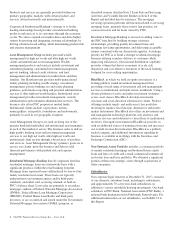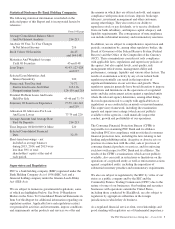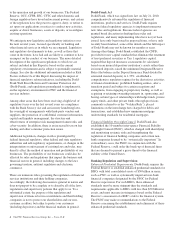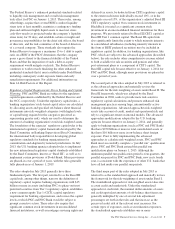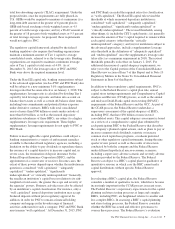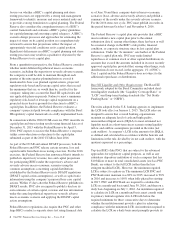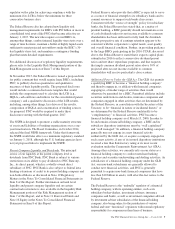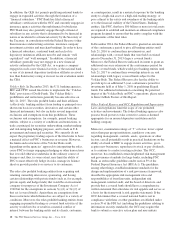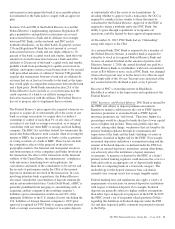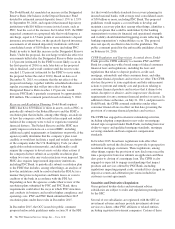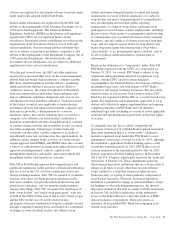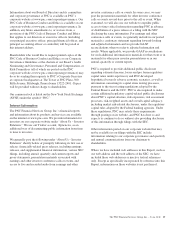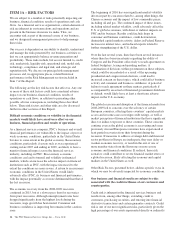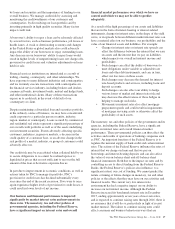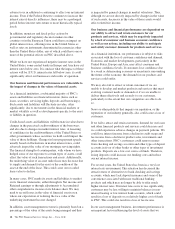PNC Bank 2015 Annual Report Download - page 27
Download and view the complete annual report
Please find page 27 of the 2015 PNC Bank annual report below. You can navigate through the pages in the report by either clicking on the pages listed below, or by using the keyword search tool below to find specific information within the annual report.
regulator with a plan for achieving compliance with the
minimum if its LCR is below the minimum for three
consecutive business days.
The Federal Reserve also has adopted new liquidity risk
management requirements for BHCs with $50 billion or more in
consolidated total assets (like PNC) that became effective on
January 1, 2015. The new rules require covered BHCs to,
among other things, conduct internal liquidity stress tests over a
range of time horizons, maintain a buffer of highly liquid assets
sufficient to meet projected net outflows under the BHC’s 30-
day liquidity stress test, and maintain a contingency funding
plan that meets detailed requirements.
For additional discussion of regulatory liquidity requirements,
please refer to the Liquidity Risk Management portion of the
Risk Management section of Item 7 of this Report.
In November 2015, the Federal Reserve issued a proposed rule
for public comment that would require large BHCs, including
PNC, to publicly disclose quantitative and qualitative
measures of their liquidity profile. The proposed disclosure
would include a common disclosure template that would
include the components used to calculate the LCR (e.g.,
HQLA, cash outflows and inflows for the consolidated parent
company), and a qualitative discussion of the LCR results,
including, among other things, key drivers of the results,
composition of HQLA and concentration of funding sources.
As proposed, PNC would be required to make these
disclosures starting with the third quarter, 2017.
The NSFR is designed to promote a stable maturity structure
of assets and liabilities of banking organizations over a one-
year time horizon. The Basel Committee, in October 2014,
released the final NSFR framework. Under that framework,
the NSFR would take effect as a minimum regulatory standard
on January 1, 2018, although the U.S. banking agencies have
not yet proposed rules to implement the NSFR.
Parent Company Liquidity and Dividends. The principal
source of our liquidity at the parent company level is
dividends from PNC Bank. PNC Bank is subject to various
restrictions on its ability to pay dividends to PNC Bancorp,
Inc., its direct parent, which is a wholly-owned direct
subsidiary of PNC. PNC Bank is also subject to federal laws
limiting extensions of credit to its parent holding company and
non-bank affiliates as discussed in Note 19 Regulatory
Matters in the Notes To Consolidated Financial Statements in
Item 8 of this Report. Further information on bank level
liquidity and parent company liquidity and on certain
contractual restrictions is also available in the Liquidity Risk
Management portion of the Risk Management section of
Item 7 of this Report, and in Note 11 Borrowed Funds and
Note 16 Equity in the Notes To Consolidated Financial
Statements in Item 8 of this Report.
Federal Reserve rules provide that a BHC is expected to serve
as a source of financial strength to its subsidiary banks and to
commit resources to support such banks if necessary.
Consistent with the “source of strength” policy for subsidiary
banks, the Federal Reserve has stated that, as a matter of
prudent banking, a BHC generally should not maintain a rate
of cash dividends unless its net income available to common
shareholders has been sufficient to fully fund the dividends
and the prospective rate of earnings retention appears to be
consistent with the corporation’s capital needs, asset quality
and overall financial condition. Further, in providing guidance
to the large BHCs participating in the 2016 CCAR, discussed
above, the Federal Reserve stated that it expects capital plans
submitted in 2016 to reflect conservative dividend payout
ratios and net share repurchase programs, and that requests
that imply common dividend payout ratios above 30% of
projected after-tax net income available to common
shareholders will receive particularly close scrutiny.
Additional Powers Under the GLB Act. The GLB Act permits
a qualifying BHC to become a “financial holding company”
and thereby engage in, or affiliate with financial companies
engaging in, a broader range of activities than would
otherwise be permitted for a BHC. Permitted affiliates include
securities underwriters and dealers, insurance companies and
companies engaged in other activities that are determined by
the Federal Reserve, in consultation with the Secretary of the
Treasury, to be “financial in nature or incidental thereto” or
are determined by the Federal Reserve unilaterally to be
“complementary” to financial activities. PNC became a
financial holding company as of March 13, 2000. In order to
be and remain a financial holding company, a BHC and its
subsidiary depository institutions must be “well capitalized”
and “well managed.” In addition, a financial holding company
generally may not engage in a new financial activity
authorized by the GLB Act, or acquire a company engaged in
such a new activity, if any of its insured depository institutions
received a less than Satisfactory rating at its most recent
evaluation under the Community Reinvestment Act (CRA).
Among other activities, we currently rely on our status as a
financial holding company to conduct merchant banking
activities and securities underwriting and dealing activities. As
subsidiaries of a financial holding company under the GLB
Act, our non-bank subsidiaries are generally allowed to
conduct new financial activities, and PNC is generally
permitted to acquire non-bank financial companies that have
less than $10 billion in assets, with after-the-fact notice to the
Federal Reserve.
The Federal Reserve is the “umbrella” regulator of a financial
holding company, with its operating entities, such as its
subsidiary broker-dealers, investment advisers, insurance
companies and banks, as well as investment companies advised
by investment adviser subsidiaries of the financial holding
company, also being subject to the jurisdiction of various
federal and state “functional” regulators with normal regulatory
responsibility for companies in their lines of business.
The PNC Financial Services Group, Inc. – Form 10-K 9





